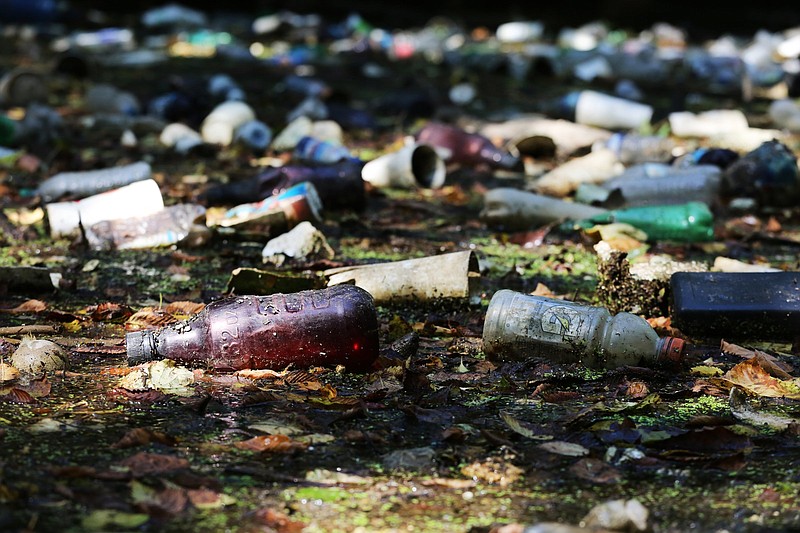Jesus said to consider the lilies of the field.
Then we must.
Because across the world, the flowers and fields are suffering.
"A growing number of pollinator species worldwide are being driven toward extinction," declares a 2016 study by the Intergovernmental Science-Policy Platform on Biodiversity and Ecosystem Services.
Monarch butterflies are disappearing; a 2018 study found an 86% decline in western monarchs.
Honeybees suffer from colony collapse disorder.
Some six million bats have died in the U.S. and Canada since 2006, when the white-nose syndrome was first discovered, according to the New York Times.
Such a pollinator collapse - the bees, bats, birds, moths, flies and butterflies - will threaten millions of lives and billions of dollars, the platform study reports.
Much of the reason is human behavior: habitat loss, pesticide use, climate change.
It's not just the flowers, but the fields themselves.
"At the very moment when we know that by 2050 we will need significantly more food, we are paving over some of our most fertile soil," writes Paul Bogard in "The Ground Beneath Us."
Of all the environmental crises, perhaps none are as pressing as the state of the world's soil, which is a nonrenewable resource. It's estimated to take between a few hundred to several thousand years to create an inch of fertile topsoil.
We're destroying it.
Some estimate the earth has 60-90 harvests left, "meaning that in fewer than sixty years the topsoil will no longer support the growing and harvesting of food," Bogard writes.
The main villains: heavy tilling and overuse of pesticides and fertilizers.
"What happens if, as projected, Tanzania's human population doubles to more than one hundred million in the next twenty years, while at the same time the soil's ability to produce crops diminishes? What happens to wildlife when millions of people don't have enough to eat? And then what happens when the wildlife is gone?" Bogard writes.
We grieved and shook when we saw the burning Notre Dame.
Yet the topsoil is burning, too.
And the coral reefs.
And rain forests.
And insect populations.
If we grieve over seeing Notre Dame collapse, what will happen to our collective psyche when we see the last elephant fall?
Tomorrow is Easter.
Passover began Friday.
Monday, Earth Day.
Ramadan begins in two weeks.
More than ever, religion and environmentalism must intertwine.
The core elements and symbols used in the centerpiece stories of Abrahamic religions - Judaism, Christianity, Islam - used to draw humans closer to God are endangered.
The Mount of Olives.
The Red Sea.
The pilgrimage to Mecca.
All are threatened.
"Parts of the Middle East, including the Gulf states and Muslim holy places around Mecca, could become uninhabitable even for the young and fit before the century is out, according to a new climate modelling study," reports the New Scientist.
John the Baptist ate wild locusts.
Locusts are insects.
And insects are dying.
"Researchers see 'horrific decline' in insect numbers," reported Fox News.
Ironically, many researchers have used a biblical term in describing insect loss.
Armageddon.
"We appear to be making vast tracts of land inhospitable to most forms of life, and are currently on course for ecological Armageddon. If we lose the insects, then everything is going to collapse," Sussex University's Dave Goulson told the Guardian.
The star of David?
"Stars vanishing from night sky as light pollution leaves just two per cent of Britons seeing true darkness," reports the Telegraph.
The serpent in the Garden of Eden?
"The world's reptiles - turtles, snakes, lizards, alligators and crocodiles - are indeed in trouble," reports The Scientific American, which claims more than 20% of reptiles around the world are endangered or facing extinction.
View other columns by David Cook
The white dove of Noah?
"The 1,300 bird species facing extinction signals threat to human health," claims the National Geographic headline. "Climate change and chemicals like pesticides are driving the crisis."
The whale that swallowed Jonah?
A dead pregnant whale washed ashore in Italy recently. Inside her belly: nearly 50 pounds of plastic waste.
The whale had swallowed fishing nets, plastic pipes, plastic plates, fishing lines and plastic bags, "some so fresh the barcodes were still readable," reports National Geographic.
Besides scientists and climatologists, we need priests, preachers, imams and poets to renew our love story with Creation.
Instead of asking what has become a politically divisive question - do you believe in climate change - we must ask:
Do we love the land?
Do we love Creation? Do we love the God that made Creation?
Do we love its skies? Its soil? Its animals?
Do we love ourselves?
"Consider the lilies of the field," Jesus said.
Now more than ever.
David Cook writes a Sunday column and can be reached at dcook@timesfreepress.com or 423-757-6329.

